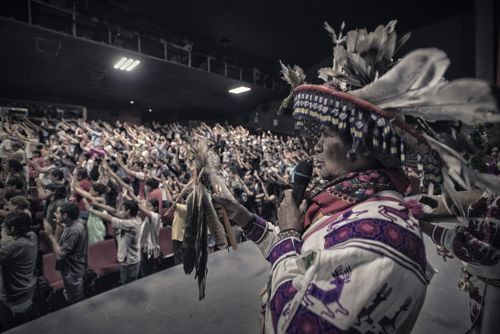
José Luis "Katira" Ramirez invokes the sacred five directions of the Huichol people in a benediction before the showing in Guadalajara (Credit: José Andrés Solórzano)
Second of two interviews
See also: Interview With the Directors of Huicholes: The Last Peyote Guardians
José Luis "Katira" Ramírez was serving as the governor of his community of San Andrés Cohamiata, Jalisco, when he met Argentine filmmaker Hernán Vilchez. He was not like any governor Vilchez had ever met. A Huichol shaman, or marakame, dressed in his colorful native clothing and distinctive plumed hat, he stood out in the urban environment of Mexico City. He had traveled far from his home in the Western Sierra Madre because his community was in crisis; the rains had not come in time and the corn crop was ruined. He had come to the megalopolis to seek support for his people, who were in dire need with their failed harvest. Another crisis, too, loomed large in his mind: the fate of Wirikuta, the sacred land of his people, destined to be churned into ore by Canadian mining companies. He had no idea how it would be done, but he knew it had to be stopped. The fate of his people -- and indeed, of the entire planet, according to his perspective -- hung in the balance.
Hernán, for his part, was traveling the planet with his film crew, seeking subjects for a German reality show that portrayed the cultures and traditions of native peoples around the world. He asked Katira if he would be willing to participate in a filming of the program. Katira said he would consult with the elders of his community, and together they would decide.
Eventually the community gave their blessing, but they asked for something in return. They wanted Hernan to film the story of their struggle to save Wirikuta.
Katira's family became the protagonists in the documentary, which follows the building of an extraordinary movement. I sat with Katira and with his son Clemente, a student at the University of Guadalajara, at the closure of the very intense Mexican film release tour to get a different perspective on the story behind the film. Producer Paola Stefani joined in at his invitation.
Tracy: Katira, how was it to live with this film crew in your house, in your life, filming every day? Because of what I know of the Wixarika people, it's a very private culture, very discreet, and people value their privacy very much.
Katira: Yes, it was very difficult. There were many people who think many things and said things to us (critical things), but you only think of the defense. I always said in the assembly, you also should do the work, this is what it costs. If there's no support, it's painful, but one does it because really they do it from the heart, because really they love the Mother and the territory, and also we have rights as guardians on this planet.
Tracy: I know that there are various documentarians who go to the sierra and ask for permission to film. Hernán is not the first; so why did you choose him to do this movie?
Katira: He has a heart to especially know us. It wasn't his first time to come to an indigenous community; he had been to communities all over the world with almost the same problems, the same needs. So when we met it was like we had already known each other for many years.
Tracy: What were the most difficult challenges for you in this process?
Katira: The difficult thing was the distances, and because of the distances the cost of everything -- it's very far and that's why, with work and with sacrifice, we did it.
Don't think it was cheap; each trip was 1500 euros, 1,000 euros, from my pocket, from my work, but working together and with a lot of economic sacrifice we were able to do everything we needed to complete this documentary, so one day people will understand.
Thank God my heart is very strong, because I wanted to leave something for the children, for the grandchildren, for the future, because I'm not going to live 500 years, 300 years, who knows what's going to happen; so this was very important for me.
Tracy: I really loved the opening you gave to the film in Guadalajara -- the ceremonial blessing, the invocation of the five directions. I was curious to know if you opened each of the presentations with a benediction like that one, or were they all different?
Katira: Very different. Sometimes we arrived rested; other times the director was really sick and weak from so much travel, with the rains, with headaches, we had to take care of each other that week of the release tour.
Tracy: Katira, I know as a marakame you are also a healer, among other things. Were there times when you served as a healer for the film crew?
Katira: Yes, laying the hands on energetically, healing, that's how we've always cared for each other.
Tracy: I'll bet you had a lot of work, no?
Katira: ¡Sí!
Tracy: And did the treatments work?
Katira: Here's Paola; ask her.
Read the full interview at Intercontinental Cry.
Anyone who is interested in organizing a film screening or supporting the effort may contact the director at hernanton@gmail.com.